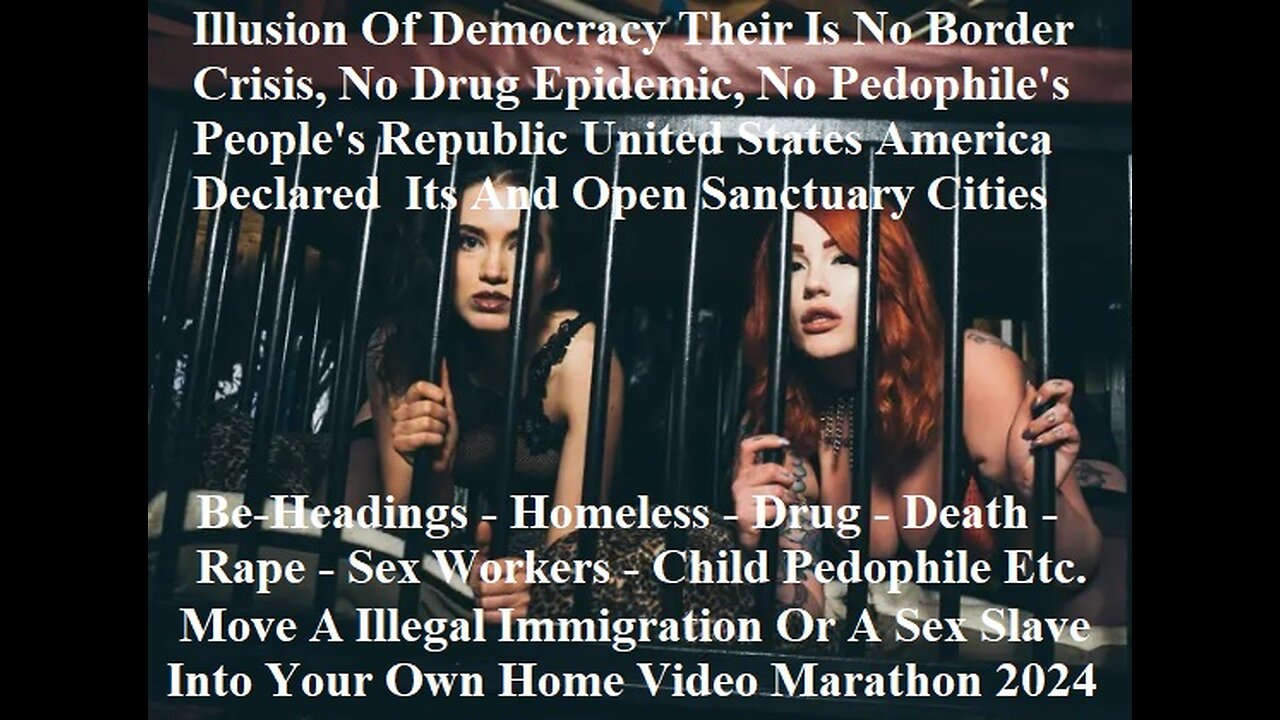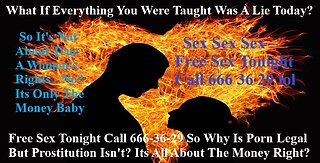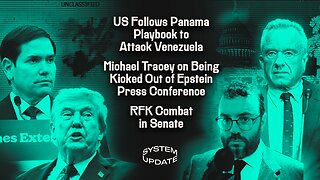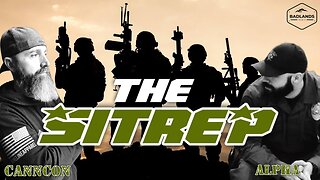Premium Only Content

Move A Illegal Immigration Or Sex Slave Into Your Own Home Video Marathon 2024
Illegal Immigration Or Sex Slave Will You Move Someone Into Your Own Home ? Worrisome stories about the illegal immigration or sex slave crisis hit the news feed every day right now. To help you understand the situation, we've carefully curated a selection of our most important and thoughtful videos on the topic. In 2000, Congress signed the Victims of Trafficking and Violence Protection Act into law, representing the beginning of a large-scale, coordinated effort by the United States government to fight human trafficking. Twenty years later, human trafficking still remains prevalent.
At any given time in 2016, an estimated 40.3 million people are in modern slavery, including 24.9 million in forced labor and 15.4 million in forced marriage.
It means there are 5.4 victims of modern slavery for every 1,000 people in the world.
1 in 4 victims of modern slavery are children.
Out of the 24.9 million people trapped in forced labor, 16 million people are exploited in the private sector such as domestic work, construction or agriculture; 4.8 million persons in forced sexual exploitation, and 4 million persons in forced labor imposed by state authorities.
Women and girls are disproportionately affected by forced labor, accounting for 99% of victims in the commercial sex industry, and 58% in other sectors
What Is Human Trafficking?
Although the legal definition of human trafficking is complex, the simple meaning of it is not. It occurs when a person is induced by force, fraud or coercion to:
Work under the total or near-total control of another person or organization (slavery or involuntary servitude)
Forced to pay off a loan by working instead of paying money, for an agreed-upon or unclear period of time (debt bondage) or even without an agreement as to the timeframe (peonage)
Perform a sex act for money or anything of value (if under 18, force, fraud or coercion is not required)
According to U.S. Immigration and Customs Enforcement, although many people think of the sex trade when they think of human trafficking, this crime also occurs in such labor situations as:
Domestic servitude
Labor in a prison-like factory
Migrant agricultural work.
In addition, with respect to labor situations, the initial agreement to travel or to perform work does not mean that the employer is later allowed to restrict a victim's freedom or use force or threats to obtain repayment.
Human trafficking and human smuggling are sometimes, but not always, linked, because not all individuals who are smuggled are trafficked, and movement is not required for trafficking to occur.
"Force, Fraud or Coercion"
These terms include any situation where an individual is forced to do something against their will, or where they are tricked into doing something by someone who is lying to them or suppressing the truth. According to U.S. Immigration and Customs Enforcement, force can be active and physical or indirect and psychological (including threats). This term includes:
Coercion - Compulsion - Constraint - Restraint
Coercion refers to behaviors including:
Threats of harm or physical restraint
Trying to get a person to believe that if they don't do something, it will result in serious harm or physical restraint of themselves or someone else
The abuse (or threatened abuse) of law or the legal process
Fraud refers to intentionally distorting the truth in order to get someone else (who relies on that version of the truth) to surrender a legal right or give up something valuable that belongs to them.
A Complex Crime
Human trafficking entangles victims in a nearly impenetrable web, for a number of reasons:
The victim may not realize that he or she is imprisoned, because coercion is psychological (it may not be physical)
Victims are typically impoverished and financially dependent on their captors
Often the crime takes place in plain view-e.g. in a restaurant, worksite, or private home-and is not immediately apparent to observers
Victims can be exploited for labor, sex, or both, particularly in private homes.
Signs of Human Trafficking
It is sometimes said that human trafficking is an "invisible crime," because its signs are not always obvious to the untrained eye. However, there are some indicators that may serve as a tip-off, particularly when they appear in combination. Suspect that something is amiss if an individual:
Lacks control of identification documents or travel documents
Lives and works in the same place
Lacks freedom of movement
Seems to be restricted from socializing, attending religious services or contacting family
Seems to have been deprived of basic life necessities, such as food, water, sleep or medical care
Shows signs of having been abused or physically assaulted. Such signs range from the more obvious, such as broken bones, to the more subtle, such as branding or tattooing
Seems submissive or fearful in the presence of others
Seems not to control his or her schedule
Seems to lack concrete short- or long-term plans
Seems to lack knowledge about the place where he or she lives
Appears to date much older, abusive or controlling men.
A Government Partnership
Four executive agencies of the U.S. government, along with state and local law enforcement organizations, work together as well as with nonprofit organizations to combat human trafficking. The primary U.S. executive agencies include:
Department of Homeland Security , of which U.S. Customs and Border Protection , U.S. Immigration and Customs Enforcement , and U.S. Citizenship and Immigration Services are component agencies
State Department - Department of Justice
Department of Health and Human Services
Initiatives - Blue Lightning - No Te Enganes - Blue Campaign
DHS Activities Combating Human Trafficking
The Department of Homeland Security and its component agencies have been raising awareness for the past several years about the issue of human trafficking. Most recently, DHS announced an aggressive effort to protect victims and prosecute traffickers, in line with the TVPA's focus on three key goals:
Prevention - Protection - Prosecution
Currently, the Department is focusing on the first of the three goals above, by sponsoring heavily advertised public awareness campaigns about human trafficking created by CBP and its sister agency, Immigration and Customs Enforcement and making potential victims aware that they are in danger, and that the government offers resources to provide them with asylum and other forms of assistance.
Actions CBP Is Taking To Enforce TVPA
With more than 42,000 frontline CBP officers and Border Patrol agents protecting nearly 7,000 miles of land border and 328 ports of entry—including official crossings by land, air, and sea—CBP is uniquely situated to deter and disrupt human trafficking. Currently, the agency is:
Identifying potential victims as they seek to enter the U.S.
Directing potential victims to U.S. agencies providing legal protection and assistance, through printed materials with educational information and telephone numbers where help can be obtained
Raising awareness among the American public of this often-invisible, yet pervasive crime, through public service announcements
Raising awareness internationally among potential border-crossers before they fall into the hands of traffickers, in countries where this crime is pervasive and where border smuggling frequently involves human trafficking
Helping the public to report suspected cases of human trafficking
Identifying imports produced by forced labor and stopping them from entering the country
Dedicating an office specifically to combating human trafficking
Partnering with other law enforcement agencies to identify and support victims, such as by educating legal counsel to detect signs of victimization, to disrupt the crime itself and to prosecute human traffickers
Partnering with non-governmental organizations to provide information about government assistance to potential victims
Participating in the development of best practices for law enforcement efforts within the U.S. and internationally.
Training is Key
Within the agency, CBP has implemented comprehensive training for its frontline personnel with more forthcoming. Through its local field and sector offices, CBP is instructing them to recognize potential instances of human trafficking and to take appropriate actions when encountering human trafficking victims.
Conclusion
Human trafficking is a heinous international crime, and as the State Department notes in its most recent report on the subject, it is unfortunately flourishing due to current global financial issues. With global demand for labor decreasing, impoverished workers find themselves taking greater risks than before in order to survive. The result: "a recipe for greater forced labor of migrant workers and commercial sexual exploitation of women in prostitution."
This number is 697,000 and That is the appalling number of individuals estimated to be involved in human trafficking in the United States, and it is more than likely a relatively conservative estimate. Even more appalling is that there are approximately 50 million people who are victims of human trafficking worldwide.
This is an industry driven by sex, with 80 percent of trafficked individuals engaged in sex trafficking of some form.
Woman account for about 80 percent of individuals involved in sex-trafficking, with some estimates stating that a quarter of these cases involve minor children. The average age for females at the time of entry into sex-trafficking is thought to be between 17–19 years old.
Victims of both sex and labor trafficking include United States citizens, but also many foreign nationals, mostly from Mexico, Central and South America, as well as the Caribbean. Now more than ever, these victims of a horrific crime are at significant risk, not just from their traffickers but from something else that can cause significant harm: the fear of deportation.
Many of trafficking victims are lured into the system with the promise of legitimate jobs, while others are kidnapped or entrapped in a myriad of ways. They are enslaved and faced with violence and torture, including threats of death. Their lives become less their own and they are bought and sold as a commodity.
Victims of trafficking brought to the United States illegally are a particularly vulnerable group. Especially now, when the Trump administration is revamping immigration policy, these are individuals at significant risk. These are people who are often afraid, alone and frequently have had their passports and other identifying papers taken from them by their traffickers. They have no way to contact family or friends, as they are stripped of their identity and have to rely on their traffickers for survival.
Unfortunately, they are also at constant risk for engagement with law enforcement. Whether through prostitution or illicit drugs, these are individuals whose activities are on law enforcement agencies’ radar. In most cases, the aim of law enforcement is to protect the trafficked individual while targeting the traffickers and those who utilize sex trafficking. While not in the crosshairs of prosecutors, these vulnerable people are still at significant risk for deportation if they are undocumented (or even documented, in many cases) immigrants, who are now in the legal system.
While law enforcement can sometimes help to protect trafficked individuals, this is not always assured. The climate of how the current administration views immigrants makes this an even more tenuous promise. While police and prosecutors try to afford protection and build their case, federal officers may take charge and initiate the process of deportation.
The ever-looming threat of deportation has some substantial consequences. It can be a significant deterrent to victims reporting their traffickers, making them even more reliant on them for a perceived protection. Many traffickers use the threat of deportation to control their victims, and the widespread enforcement of immigration policy reinforces that fear. There is also the fear of retaliation, as threats that traffickers will harm victims and their families is an oft used tactic to maintain control.
There have been efforts to afford some protection. The T visa, a special visa to protect victims of trafficking was created in October 2000 with the passing of the Victims of Trafficking and Violence Protection Act. There are 5,000 of these visas available on an annual basis. This would seem promising, but it is a significantly under-utilized process. According to the United States Citizenship and Immigration statistics, only around 500 – 600 of these visas are granted each year. In addition, the burden of proof can be on the trafficked victim and there are a number of requirements to qualify. This often includes testifying against their trafficker, something that can be terrifying for these individuals.
T visas are also temporary, only lasting for four years. Although individuals can apply for a green card after the third year, that process is also under-utilized and slow.
We need to look closely at how victims of human trafficking, especially those who are immigrants, receive protection. Human trafficking is by all accounts a human rights violation. It is our duty as humanitarians to protect those who cannot protect themselves. Under the current policy, it is at the discretion of law enforcement and prosecutors to make this information and resources available. The current climate regarding immigration, the burdensome process and limited resources all have lead to underutilization of this important protection.
One policy solution to improve access could be to require prosecutors to inform and facilitate the T visa process. It should be made part of the process of assisting victims of trafficking, not an extra, discretionary step. Similar to other victim advocate programs, there should be support to help the individuals fill out and complete the lengthy and sometimes confusing applications. It should also involve transparency, illuminating the process and ensuring fairness and equity.
It is important for policy makers and stakeholders to consider the T visa process, especially as new immigration policies and practices are formulated at the federal level. This is an important protection for people who have been victimized and forced into slavery and it is an imperative to increase awareness of access to this important safety-net for some of the most vulnerable people in the world.
Why Don’t Immigrants Apply for Citizenship?
There Is No Line for Many Undocumented Immigrants. Many people wonder why all immigrants do not just come to the United States legally or simply apply for citizenship while living here without authorization. These suggestions miss the point: There is no line available for current undocumented immigrants and the “regular channels” are largely not available to prospective immigrants who end up entering the country through unauthorized channels. Even though more than 80 percent of undocumented immigrants have lived in the United States for over 10 years, many could live out the rest of their lives without any opportunity to become legal residents of this country.
No “line” is available for the vast majority of undocumented immigrants.
Immigration to the United States on a temporary or permanent basis is generally limited to three different routes: employment, family reunification, or humanitarian protection. Each of these legal avenues is highly regulated and subject to numerical limitations and eligibility requirements. As a result, most undocumented immigrants do not have the necessary family or employment relationships and often cannot access humanitarian protection, such as refugee or asylum status. This means that no matter how long they have been in the United States, most undocumented immigrants have no way of achieving legal status. Even those who pay taxes, work hard, and contribute to their communities have no way to “get in line” unless Congress creates a new pathway to legal status.
Many undocumented immigrants are barred from obtaining legal status while inside the United States.
Unauthorized Undocumented immigrants who entered the United States without being legally admitted and inspected are generally not eligible to obtain green cards while still inside the country. Even if there is a visa available, they are barred from “adjusting status” and getting a green card without first leaving the country because of how they entered the United States.
However, leaving the country to obtain a visa can have significant negative consequences. Any person who has been out of status for more than 180 days, but less than one year, is barred from being re-admitted or re-entering the United States for three years; while anyone who has been out of status for more than one year is barred for 10 years. Although waivers to these bars exist, they are difficult to obtain. This means that even when a visa is available, undocumented immigrants must risk spending up to 10 years away from their families in the United States before being allowed to reenter the country.
Family-based immigration is limited to certain close family relationships and is numerically restricted.
Most people who legally immigrate to the United States come through family-based visas. Qualified family members in the United States can seek permission to bring in certain eligible foreign-born family members. U.S. citizens can petition for their spouses, parents (if the petitioner is 21 or older), children, and siblings. Lawful Permanent Residents (LPRs, or “green card” holders) can petition for their spouses and unmarried children (of any age). There are always visas available for the spouses, parents, and minor children of U.S. citizens, but for all other family categories there are annual numerical limits. In all cases, the petitioning family member in the United States must demonstrate an income level above the poverty line and must commit to support the family members they are seeking to bring to the United States. The foreign-born persons wishing to immigrate must meet eligibility requirements as well. This means that a family-based visa is unavailable to any undocumented immigrant who doesn’t have a qualified relative or who fails to meet those eligibility requirements.
Employment-based immigration requires a U.S. employer to request specific foreign workers.
To come to the United States for employment purposes—either temporarily or permanently—foreign workers must generally have a job already lined up with an eligible employer who will commit to being a sponsor. An employer can request permission to bring in specific qualified foreign workers, but only if they meet the requirements (such as job skills and education level) and if the employer cannot find qualified U.S. workers to take the job first. Most of the qualifying professions for permanent immigration require high levels of education and professional experience, such as scientists, professors, and multinational executives. There are a limited number of temporary visas for highly skilled or internationally recognized workers, and temporary, seasonal visas for agricultural workers and certain other “less-skilled” workers. In most of these cases, an employer must petition for the worker.
Very few undocumented immigrants are eligible for employment-based visas, and competition for these visas is fierce. This means that for all but a lucky few, these visas are unavailable to undocumented immigrants regardless of skill or desire to work legally.
Most people fleeing their home countries cannot access humanitarian protection.
Each year, the United States sets a numerical limit on how many refugees will be admitted for humanitarian reasons. To be admitted as refugees, individuals must be screened by multiple international and U.S. agencies and demonstrate a “well-founded fear of persecution based on race, religion, membership in a particular social group, political opinion, or national origin.” Asylum seekers are individuals already in the United States who fear returning to their home countries, and who must prove they meet the definition of a refugee. An immigrant does not qualify as a refugee or an asylee because of poverty or difficult economic conditions in their home country. Most undocumented immigrants are ineligible for asylum because the law generally requires that someone file for asylum within one year of entering the United States. There are other more limited forms of temporary humanitarian protection available, but these are rare.
Even those who can get in line are subject to long backlogs and waits.
When undocumented immigrants do have qualifying relatives or employers who could provide a pathway to a visa, many are still not able to take advantage of that process for years. The demand from both family members and workers who want to immigrate to the United States is typically higher than the number of slots available each year. In addition, there is a maximum number of employment-based and family-sponsored preference visas that can be issued to citizens of any one country each year. The number of permanent immigrants from a single country cannot exceed seven percent of the total number of people immigrating to the United States in a single fiscal year. Only immediate relatives of U.S. citizens (parents, children under 21, and spouses) are not subject to a numerical limit. This results in significant backlogs for most family members and many workers hoping to enter the United States legally, with some immigrants from certain countries waiting decades. Moreover, for the past two years the federal government has not even come close to meeting the annual caps for either employment-based or family-preference visas due to the slow pace of processing.
People from countries with high levels of immigration to the United States—Mexico, China, India, and the Philippines—generally have the longest waiting times for immigrant visas. For example, the married and unmarried adult children of U.S. citizens from Mexico, and the Filipino siblings of U.S. citizens, must wait between 19 and 24 years for visas to become available.
There is a limited lottery for certain countries.
If a person who wishes to immigrate to the United States does not qualify under the family, employment, or humanitarian systems, there may be one more legal path. The annual Diversity Visa Program makes up to 50,000 green cards available to persons from countries with low rates of immigration to the United States. People from Mexico, China, the Philippines, India, and other countries with higher levels of immigration to the United States are not eligible. To qualify, applicants must have a high school education and two years of job experience. Since millions of people around the world apply each year, the chances of obtaining a visa through the lottery are extremely low. In addition, the Diversity Visa Program is barely functioning at the present time due to the continued impact of immigration bans implemented by the Trump administration and extremely slow processing by the Biden administration.
Conclusion
Undocumented immigrants who want to become citizens of the United States cannot just “get in line.” Although there are some lines, many aspiring lawful permanent residents are not eligible to be in any of them. Even if an undocumented immigrant does meet the formal requirements to immigrate, the wait can be very long if the individual is applying from a country with a lengthy backlog of applications.
Home Office reclassifies modern slavery as illegal immigration issue The Home Office has taken the modern slavery brief away from the minister responsible for safeguarding and classed it as an “illegal immigration and asylum” issue, updated online ministerial profiles show.
The move is seen as a clear sign that the department is doubling down on Suella Braverman’s suggestion that people are “gaming” the modern slavery system and that victims of the crime are no longer being prioritised.
The previous safeguarding minister, Rachel Maclean, had modern slavery on her official list of ministerial responsibilities but her successor, Mims Davies, has no mention of the crime on her list. Instead, modern slavery is listed at the bottom of the “illegal immigration and asylum” brief of immigration minister Tom Pursglove.
Under Theresa May, the government pledged to be world leaders in combating modern slavery but Braverman said last week that trafficking claims from “people gaming the system” were “derailing the UK’s policy on illegal migration”.
The shadow home secretary, Yvette Cooper, said: “The largest single group of modern slavery victims under the referral system last year were British children – including those who were exploited through county lines.
“The evidence shows the majority of exploitation takes place in the UK rather than across borders.
“The government should be treating this as an enforcement and safeguarding issue and taking stronger action against the crime of modern slavery wherever it takes place.”
Charities working with victims say characterising the crime as an illegal immigration issue is dangerous. More than a quarter of all people identified as potential modern slavery victims are British, according to official statistics.
Olivia Field, head of policy at the British Red Cross, said: “Modern slavery is a crime that can impact people no matter where they are from or where they are in the world.
“From our work supporting people who have been through horrific experiences including sexual exploitation and human trafficking, we know there are urgent improvements needed to better protect and support survivors.
“So it doesn’t become any harder for people to get the help they need, we would urge the lens on tackling modern slavery to be a safeguarding one focused on protecting people impacted by this crime, as opposed to being treated as an immigration issue.”
Despite Braverman’s claims of people “gaming” the system, 97% of all modern slavery referrals concluded in the first half of this year were confirmed as genuine by the authorities.
The home secretary’s comments were contradicted by the chief executive of the Gangmasters and Labour Abuse Authority, Elysia McCaffrey, who said: “We don’t see people gaming the system … What we see is vulnerable people who are being exploited by opportunists and criminals.”
Kate Roberts, head of policy at Focus on Labour Exploitation, said: “Modern Slavery is a serious crime which is carried out against individuals and to see it as an immigration matter is wrong and is risky.
“Preventing and addressing modern slavery should take a person centred approach – starting with safeguarding and ensuring the rights of potential victims. While restricted or insecure immigration status can be abused by exploiters who use immigration detention as a threat against seeking help from the authorities, this is only one of many tools traffickers use, as evidenced by the fact that many British people are victims of trafficking.”
In another sign that the government is no longer prioritising tackling the crime, there has been no independent anti-slavery commissioner in post since Sara Thornton left in April, despite it being a legal requirement since the introduction of the Modern Slavery Act in 2015.
A Home Office spokesperson said: “We are committed to tackling the heinous crime of modern slavery and in the UK we have a world-leading response. However, it is clear people are abusing our system when they have no right to be here, in order to frustrate their removal.”
Illegal immigration is bringing slavery into America
Stopping exploitation of children begins with border security
There is a very real human cost to open borders: modern-day slavery.
Right now, our southern border is the least secure in history, and Mexican drug cartels are making a killing by taking advantage of migrants on the journey to our country.
Sadly, migrant women and children are often raped, robbed, and forced to smuggle drugs, and those who cannot pay their fee, or “piso,” for passage to the U.S. are trapped in indentured servitude in fear for their own lives or their families.
More than 6 million illegal aliens have crossed our border in the last 27 months. This is human suffering on a massive scale.
This would not be happening if not for the Biden administration ’s unlawful open border policies, which continue to encourage millions more migrants to subject themselves to exploitation and make it easier for cartels to generate billions of dollars in smuggling fees.
That said, the physical, emotional and sexual abuse on the journey north is just half of the harrowing reality. The other half is the largely overlooked story of countless migrant children suffering on this side of the border in our own communities.
In February, The New York Times released a bombshell investigation, “Alone and Exploited, Migrant Children Work Brutal Jobs Across the U.S.” It shed light on the lives of migrant children once they reach the border and are released into American communities.
Unbeknownst to many Americans, factories and other job sites around the country are packed with underage migrant children unlawfully working with dangerous machinery for long hours.
Children as young as 12 work as day laborers and in construction. They skip school, lose sleep, and have no families to go home to. In the words of the reporter Hannah Dreier, “This shadow work force extends across industries in every state, flouting child labor laws that have been in place for nearly a century.”
In the past 27 months alone, more than 370,000 children have come to our southern border unlawfully without any parents. In the investigation, a reported two-thirds of these children work in these illegal jobs that carry a high risk of injury or death.
Anyone in their right mind would wonder: How does this happen? As The New York Times’ investigation details, children are released to unvetted “sponsors” who sometimes turn out to be abusive slavers who force them to work to pay off the smuggling debts.
Others are pressured by their families to cross the border alone to work and send money home. They become trapped in indentured servitude when they cannot pay the passage fee to the cartels, and they must work to pay off debts as high as $20,000.
In each of these situations, the open border policies of the Biden administration have made it easier for these bad actors to enslave and harm children. Here’s how.
First, the administration loosened vetting standards for both sponsors and volunteers who take children into their custody when they arrive unlawfully. These sponsors do not even have to complete or pass a background check.
Caseworkers say they “rush through vetting sponsors” and described “many reports of trafficking,” but no consequences for the traffickers. One of the sponsors of a child featured in this investigation stole his paycheck from painting houses every day and watched him sleep on the floor.
Second, the Biden administration has ignored the widespread hiring of illegal immigrants and removed a record-low number of children arriving unaccompanied, which increases the incentive for families to send their children to work across the border illegally.
Third, the Biden administration has not cracked down on the cartels. The open border fuels the cartels’ activities, so the federal government must get smart about stopping them.
Reinstating nationwide “catch and release” has assured millions of migrants, especially children, that when they come to the border, they will be let into American communities with virtually no consequences. As a result, they make the journey north and suffer at the hands of the cartels.
Stopping this historical exploitation of children begins with securing the border and enforcing consequences for unlawful entry, which will give the cartels less business. We must also take on the cartels more directly by imposing harsher penalties on trafficking, smuggling, and other forms of exploitation.
Migrant children should be released only to sponsors who have been thoroughly vetted, and all volunteers working with them must be required to pass a background check. And labor enforcement must be prioritized so that children do not work in these underground, illegal and dangerous jobs.
At the end of the day, the Biden administration has sold a lie to the American people that their policies are compassionate and that we are helping migrants by leaving our borders open. Yet they are silent about the suffering of these vulnerable children and the cruelty of the cartels inflicting harm on all those who attempt to cross our borders.
Millions more will continue to suffer if the Biden administration does not correct course and return to policies that protect vulnerable children and defeat the cartels.
Is It Illegal to Transport an Undocumented Immigrant Within the U.S.?
Federal laws concerning transport of aliens who are in the U.S. illegally; and developing state laws on the matter.
Many undocumented immigrants or aliens live in the United States, and it's entirely possible that you know some, perhaps without realizing it. That has led some people to worry that it could be a crime to give one of them a ride, for example in a carpool or even while driving for a ridesharing app like Lyft or Uber. While this is unlikely to be a problem for the average driver under federal law, drivers who cross state borders should be aware of how they could be affected by new state laws.
Federal Law Makes Transporting Undocumented Immigrants a Crime
A federal law does exist that makes it a crime to transport (or attempt to transport) an undocumented noncitizen within the U.S., but it's meant to cover narrower situations than everyday situations like offering a ride. The law is found within the Immigration and Nationality Act (I.N.A.), at Section 274(a)(1)(A)(ii).
In order to convict someone under this section of the law, the prosecutors would need to prove each of these things:
the defendant transported or attempted to transport a noncitizen within the U.S.
the noncitizen was in the U.S. in violation of U.S. law (as would be the case with any undocumented person )
the defendant was aware that the noncitizen was in the U.S. unlawfully and acted in reckless disregard of this fact, and
the defendant acted "willfully" in furtherance of the noncitizen's legal violation (in order words: voluntarily and intentionally helped the noncitizen to intentionally violate immigration law)
A friend or neighbor who has been driving (transporting) a foreign-born person around, and might not even be entirely sure of their immigration status, doesn't really fit this profile. The classic situation this law is meant to address is that of a driver who picks up unlawful entrants right after they've crossed the U.S. border and takes them closer to civilization, likely motivated by profit.
In fact, federal courts have decided that not even the act of transporting undocumented workers from one job site to another is a crime under this section. (See U.S. v. Moreno, 561 F.2d 1321 (9th Cir. 1977). Similarly, the law is carefully written so as to avoid the possibility that a bus or taxi driver could be prosecuted for unknowingly picking up an undocumented immigrant. The prosecutor would have to prove the driver intentionally helped the undocumented person break the law.
Penalties for Transporting Undocumented Immigrants Under Federal Law
If, despite this description, you're still worried that the worst might happen if you interact with undocumented immigrants, you probably want to know the possible penalty for this crime. Federal penalties can include a fine, a prison term of up to five years, or both. That penalty goes up to a possible ten years if the driver was acting for commercial advantage or private gain, and to 20 years to life in prison if anyone is seriously injured or dies as a result of the crime.
Consult a lawyer if you feel you need more information or a personal analysis.
How Is Florida Addressing Transport of Undocumented Immigrants?
Although immigration law is mostly handled at a federal level, in July of 2023, a Florida law went into effect that specifically makes it a crime to transport undocumented persons into the state. The ACLU and other organizations have challenged this law in federal court as unconstitutional. As of the date this article was last updated (January 2024), the case is ongoing, and the law remains in effect. This section will cover what the law says and the maximum penalties for violating it. However, the status of this law could change in the near future, so if you're concerned you could be charged under this law you should consult an attorney.
FL 1718 works by expanding the definition of human smuggling in Florida's human smuggling laws. Before FL 1718, it was already illegal to smuggle people across the U.S. border into Florida—its borders naturally limited that to the coastlines. The additions to state law, however, make it a crime to transport any undocumented person into the state. (You can read a breakdown of the exact changes in the text of the bill.)
This means Florida can prosecute you for helping someone enter Florida from another state while they are undocumented. It adds higher penalties for transporting minors, and it is broad enough to include transporting yourself, if you are undocumented. For example, if you came into the U.S. legally, but your minor child did not, and you bring your child to Florida, you could be charged with a felony and prison time, which can be grounds to revoke your visa.
Requirements to Convict Under This Section of Florida Law
In order to convict someone of transporting an undocumented person (which can include yourself), a Florida prosecutor would have to prove:
the defendant knowingly and willfully (intentionally) transported an undocumented person into Florida
the undocumented person entered the U.S. in violation of U.S. law, and has not been inspected by the federal government since entering
the defendant knew, or reasonably should know, that the undocumented person entered the country illegally and has not been inspected by the federal government since entering.
The law does not define exactly what "undocumented" or "inspected" mean. A person who obtained a valid visa is clearly documented and has been inspected. However, it is unclear whether a person would be considered inspected if they entered without a visa, in order to apply for asylum or refugee status, for example, and their petition is currently being processed.
If you're confused, you're not alone. This law's lack of clarity is just one of the reasons it has been challenged in the courts.
However, a few things about the law are fairly clear. You probably don't have to worry about this law if:
you're already in Florida and not crossing the border, no matter your immigration status or who you are transporting
you're planning on entering Florida, and everyone in the car is a documented foreign national or U.S. citizen (including yourself),
you're a driver for a rideshare app crossing into Florida, and you yourself are a documented foreign national.
Penalties for Transporting Undocumented Immigrants Under Florida Law
If you're worried about Florida's law, you should know that the penalties are much higher than the penalties for violating the federal law. The minimum penalty is a third-degree felony charge punishable by up to 5 years in prison and a $5,000 fine per person transported. Repeat offenses can increase the penalties. Repeated violations of Florida's new "human smuggling" provisions can even establish a pattern of "racketeering" activity, a first-degree felony charge punishable by up to 30 years in prison and a $10,000 fine.
How Would You Know Someone's U.S. Immigration Status in the First Place?
There's no reason to jump to conclusions about someone's immigration status. Even an immigrant who doesn't have a green card (lawful permanent residence) might at least have temporary permission to be in the U.S., along with a work permit. Perhaps they're an applicant for asylum or some other legal status. U.S. government processing backlogs are so long that some people wait years for final decisions on immigration applications, and in some cases they can work while they wait.
What About Other States' Laws on Transporting Undocumented Persons?
As of December 2023, Florida is the only state to make a law like the one described above. However, if this law is upheld by the courts, there is a good chance other states will pass similar laws.
Who Is an Undocumented Immigrant?
Answers to common questions about illegal immigration in the United States and what it means to be undocumented.
The easy definition of an undocumented immigrant is a foreign-born person who doesn't have a legal right to be or remain in the United States. But that's where the easy part stops. Let's look at some common questions and misconceptions about undocumented immigrants.
Is an Undocumented Immigrant the Same as an Illegal Alien?
Theoretically yes, but "illegal alien" is not a technical term. It's popularly used jargon, nowhere found in the U.S. immigration laws. Because of its insulting connotations, however, we at Nolo prefer to use more neutral terms like "undocumented immigrant" or "unauthorized immigrant."
How Many Undocumented Immigrants Are in the United States?
Estimates place the number of undocumented immigrants in the U.S. at around 11 million. Of course, it's an impossible number to know precisely, since it can change rapidly as people come and go, and because this is a population that attempts to stay under the radar.
Do all Undocumented Immigrants Sneak Across the U.S. Border?
Some, but not all. Although accurate numbers are hard to come by, it's clear that a significant number of undocumented immigrants originally came to the U.S. legally from various countries, whether as tourists or using some other nonimmigrant (temporary) visa. Then they failed to leave after the expiration date of their permitted stay arrived.
Overstaying a visa carries its own consequences under U.S. immigration law.
Why Hasn't the U.S. Deported All Undocumented Immigrants?
The reason not all undocumented immigrants have been deported is partly because U.S. enforcement resources are insufficient to keep up with the numbers. Detaining and deporting even one person costs many thousands of dollars.
It's also important to understand that there are gray areas, where someone who might be viewed by some as undocumented has what almost amounts to a right to remain in the United States. For example, asylum seekers being sought for persecution by their own government, who are unable to make direct contact with a refugee agency in their own country, might have no choice for U.S. entry but to come illegally. If stopped at the border, they should be allowed to state their claim and, if their fear is found credible, to see an immigration judge.
Or, an asylum seeker who makes it into the U.S. unseen has one year in which to prepare an application for asylum. Although the person has no actual right to be in the U.S. during that time, a would-be applicant who is caught and placed into removal proceedings can claim asylum at that point, and might very well be approved for asylum (and one year later, be eligible for a green card).
What's more, under a policy called "prosecutorial discretion," various immigrants, such as students and those with close family members in the U.S., are supposed to be largely left alone by the immigration authorities, so that the authorities can concentrate on immigrants who are criminals or otherwise a risk to U.S. society. Some of these immigrants may actually be granted a sort of limbo status called "deferred action," and in some cases a work permit. See, for example, Deferred Action for Childhood Arrivals (DACA).
Some undocumented immigrants might also have the right to remain in the U.S. based upon a valid claim for Temporary Protected Status (TPS) or another form of immigration relief.
Is It Illegal to Hire an Undocumented Immigrant for Temporary Work or Childcare?
If you hire independent contractors, you're exempt from federal labor laws that require verifying everyone's lawful immigration status. (See Documentation Required to Work in the United States.) As soon as you become an employer however, even if it's just employing a nanny, you do fall under federal provisions making it illegal to hire an undocumented person. See, for example, Risks to Hiring an Undocumented Nanny.
Illegal Immigration & Sex Trafficking – Who Is At Risk?
Slavery is not dead. This wretched practice is alive and well around the entire world. In fact, there are around 2 million sex slaves today. I recently did a study of illegal immigrants in the U.S. who commit sex crimes. In the process, I discovered that there are many illegal immigrants who are the victims of sex crimes. Being illegal immigrants, many times, they remain silent, and with silence, bad things prosper.
Women and girls are trafficked from many countries in Europe, Asia, Africa, Latin America, and the Middle East. Mexico is the number one source for young female sex slaves in North America. Tlaxcala, in Central Mexico serves as a hotbed for slave traders. Young women and girls are abducted, tricked, and sometimes sold by poor families into a caged life. Highly prized are 12 year old girls sneaking across the border into the United States. The girls are grabbed by Los Lenones, aka pimps, and dragged to unfamiliar areas where they are ‘broken in.’ It is well known that this often occurs in Mexico. The initiation process entails 20-30 men per day having brutal sex with the girls and women. Victims are beaten, drugged, and repeatedly raped until their wills are broken. It is then that the sale is possible.
‘Buyers’ can travel to various countries and actually buy females for the sole purpose of using them as sex slaves in the United States. Once the ‘buyer’ arrives in a country, it is easy to find ‘sellers’ ready to move their ‘merchandise.’ In some instances, a buyer is brought to a secluded location, where sellers actually make the female victims strip. This is to ensure that the victim looks good and has no visible defects. Likewise, in parts of Mexico, captives are made to parade in front of potential customers, much like cattle at auction. Vendors are even present to sell snacks.
Whether they come from Russia, China, or Mexico itself, it is often easiest for traffickers to bring the females across the U.S./Mexico border because it is not sufficiently guarded. Some go through checkpoints with fraudulent paperwork. Others go by foot. The U.S. State Department estimates that 10,000 human beings are trafficked into the States as sex slaves every year. Numbers available almost 10 years ago show that there were 5,000 Asian female sex slaves in Los Angeles alone. However, it is impossible to know exact figures because victims are tormented and intimidated into silence.
Once in the States, the women and girls are forced into isolation. Many times they do not see the outside for long periods of time until the pimps decide to rotate them to other cities. Inside their living hell, the females are regularly beaten and sometimes tied to the beds. They remain inside and are constantly pushed to service customers 24 hour a day. In fact, it is reported that there are often long lines of 30-35 offenders who are waiting to pay for sex with a pretty young girl. If the girls resist, they are tortured, raped, drugged, threatened, or sometimes even killed. There are cases where the girls are hung by the ceiling and beaten with baseball bats, and others where the females are starved. To add insult to injury, men sometimes videotaped the sex to use as pornography.
Surprisingly, the brothels can take the form of homes, apartments, spas, massage parlors, and hotels. At the brothels, customers have several choices: toddlers, pre-teens, and teens. Though customers are supposed to wear condoms, they often do not. Thus, the women and girls run the risk of being exposed to sexually transmitted diseases, including HIV. And of course, without condoms, the females can become pregnant. In the event of a pregnancy, the females are either forced to have an abortion or their children are snatched away and used as leverage. Often, the women and girls do not speak English, and so, even if they could run away, they have no way to communicate their plights. Brothels can be located anywhere. Even middle class neighborhoods can be at risk.
The females are usually young and idealistic. Many hope to come to the United States for a better life, and in the process, they are re-routed into terror. Some make the mistake of trusting someone who lies to them. Others attempt to sneak into the U.S. and get kidnapped along the way. And yet others are simply sold by parents. These girls tend to be loyal but emotionally or physically abandoned. They are surrounded by high stress levels and are often uneducated and unskilled. They truly desire the opportunity to work in the U.S. Sadly, many come from countries where police are as corrupt as their traffickers, so when they reach the States, they are reluctant to seek the help of law enforcement.
The typical pimp is said to resemble the victims in race and background. In fact, many times, the traffickers are naturalized citizens who still have ties to their home countries. They have a network of criminal associates who provide them with females. Usually, the perpetrators work their way through criminal organizations until they have built wealth from selling sex slaves. The crime is lucrative, and the supply of females is virtually endless.
Perpetrators can be of any age and race, though kidnappers tend to be younger than those who actually run the brothels. Those who engage in such activities tend to be psychopathic and sadistic. They have no concern for the females. They keep the girls in deplorable conditions and show open contempt. As the females are broken down and become more compliant, the traffickers become more demanding and demeaning, often requiring manual labor on top of prostitution. Both women and men are perpetrators, and the females are no less brutal than their male counterparts. These offenders spend extravagantly on themselves and are less likely to have any stable work history. They make their money from criminal enterprise, and their best skills appear to be manipulating and deceiving.
These pimps usually target an audience of their own community. That is, if the perpetrator is a Caucasian from a middle class background, he sells slaves to others from his background. Or, if the perpetrator is an individual from Mexico or Russia, he serves a migrant community. Those in the cities often focus on using store fronts to hide their activities. Those who target migrant communities search for remote farms where the illegal activity is less likely to be discovered.
Entry into the U.S. is perceived to be relatively easy at the U.S./Mexico border. Thus, this is a main artery for this activity. Puerto Rico is another point of entry as there are only 23 U.S. border patrol for the entire island. Once individuals enter Puerto Rico, with fake paperwork, coming to the mainland is simple. This is a dangerous open back door to the U.S., and traffickers are taking notice.
Serial killers. Pimps. Gangs. Any one of the most vicious sexual offenders can prey upon illegal immigrant females coming into the States. Kidnapping these girls as they sneak across the southern U.S. border is relatively easy. Dumping the lifeless bodies in the desert is also easy, and without identification, solving the murders is extremely difficult.
People need to become more aware of all victims of sex crimes. Whether it is an illegal immigrant committing these crimes, or whether it is an illegal immigrant who is a victim, the problems need to be exposed and addressed. No one is above the law. No one is allowed to commit sexual homicide or sex crimes and trafficking.
Welcome To Our Channel 2.5 Million+ Views In 2023 & 596 Video's & 13K Followers... So Far This Year Alone - Thanks To Everyone Who Like Us... Good Or Bad You Are All Welcome To Share Any Video's We Post To Your Friends And Other's... Thanks !
What If Everything You Were Taught Was A Lie? All Info. shared in this channel is for non-hate and non-race and historical purposes to educate, elevate, entertain, enlighten, and empower through old and new film and document allowance is made for fair use for purposes such as criticism, comment, news reporting, scholarship, and research. Fair use is a use permitted by copyright statute that might otherwise be infringing. non-profit, educational or personal use tips the balance in favour of fair use.
Note: We Do Not Post Any False Video's Or Un-True Content On This Channel & All Origins Video's And All Scientific Conspiracy Theory All Content And All Text Our True Statement From The Video's Owner's Who Posted There Video's To This Free Speech Channel By Us In The First Place To Be True !
Welcome To The New World Order - The Year Zero - The Real Origin of the World - National Anthem of the United States of America and Confederate States of America National Anthem and New World Order National Anthem Is "The Ostrich" Lyrics by Steppenwolf from the album 'Rest In Peace' 1967-1972 A.C.E. The Conspiracy to Rule Your Mind chronicles how the ruling elite have established global domination and the ability to effect the thoughts, decisions, and world view of human beings across the globe by systematically infiltrating the media, academia, industry, military and political factions under the guise of upholding democracy. Learn how this malevolent consortium has dedicated centuries to realize an oppressive and totalitarian rule through any means necessary, not limited to drug trafficking, money laundering, terror attacks and financial crisis within the world economy.
Worldwide tyranny is already in full effect, the food we eat and the air we breathe are not off limits. Will we be able to stop this madness before we become an electronically monitored, cashless society wherein ever man, woman and child is micro chipped? We live in the world where sex is free and love costs, where losing a phone is scarier than losing morale, where it is fashionable to get drunk and using drugs, because if you don’t do that, you’re old and out, where men cheat on their wives with girls and if they don’t, it’s for fear of being caught, where girls are more afraid of being pregnant than getting AIDS, where pizza delivery is faster than an ambulance, where clothes decide a person’s value and money is more important than friends and family... This is not my world. Where has my true world gone? The New World Order Is Upon Us - Preserve Your Liberty By Being Prepared ! - We The People of the New World Order Thank You.
The Left/Right paradigm isn't only exposed by race and immigration issues. The Left and Right are in lockstep on every issue that really matters: The IRS. Income tax. Federal Reserve system. Endless wars. Endless expansion of tyranny and ever contracting liberty. Chronically wide-open borders. Suicidal immigration policies. Don't you see? The democrats and republicans exist only to provide the illusion of choice. A strong "us versus them" simulation in every election. It's ritualized tribalism. But the joke is, it doesn't matter which team wins, because both sides have the same agenda. God, guns and gays are phony "issues" to bolster the illusion of "difference" between the parties. The only thing that makes all this possible is that people aren't aware of the scam. Just knowing they are either "Team Red" or "Team Blue" liberates them from the responsibility of having to actually know or think anything. Then they feel righteous when their team wins, or despondent when they loose. It's no coincidence that the system works exactly like sports. There comes a point when ignorance and apathy become treason. We are past that point, people.
Everything you want to know what could be more terrifying than being trafficked for sex? Being murdered in a ritual sacrifice. And even worse than that would be being murdered in a ritual sacrifice so wealthy elite cabalists can harvest your adrenal glands to get the compound Adrenochrome they need to prolong their decrepit lives! It's so easy to be overwhelmed and feel beaten by the amount of negative and discouraging information being spread by the mainstream (fake stream) media. There are truly awful people in WEF and WHO, who want to reduce us to the level of serfs or chattel, but we can resist, indeed, we must resist. Be calm, be objective and be positive. Right is Might. “The only thing necessary for the triumph of evil is that good men should do nothing.” Nobody Is Safe From People's Republic Of The Tyrannical We The Sheeple People of The United States of America and A Real True Bill of State Rights Of Government July Forth 1776 The Bill of Rights is the first ten amendments to the United States Constitution, which limit the power of the federal government and guarantee certain freedoms and rights to all colour of people and for the citizens of All America.
Thanks For Calling and Remember the U.S. Government Leave No Witnesses Alive Behind Them. If You See Fraudulent or Criminal Activities by U.S. Government. Please Call Us (ASAP) So We Can Send Someone Out To Kill You! Thanks Again For Calling.
The Presidential Hotline Pedophile and Secret Human Trafficking and Child Sex Ring Etc. Call 1-866-4-5455-968 ( 1-866-I-Kill-You ) should be used when all your attempts to get assistance from a government department, province, municipality or state agency have failed. It is not only a complaints line. You can call to share your views or provide solutions to the challenges in your community. We also list the help line numbers of non-governmental organization's working with government. You may call at 987-654-3210 ext. new world order!
In 1984 Tried To Warn Us We The People About Every record has been destroyed or falsified, every book rewritten, every picture has been repainted, every statue and street building has been renamed, every date has been altered. And the process is continuing day by day and minute by minute. History has stopped. If you want a picture of the future, imagine a boot stamping on a human face forever. Thank You To Everyone From Us.
Illusion of Democracy Who Really Controls Our Lives Their Is No Border Crisis, No Drug Epidemic, No Pedophile's. So People's Republic Of United States Of America Declared Its An Open Sanctuary Cities Is Open To All As Planned In The First Places. So If You Are A Good Person Or A Bad Person Or Really Who Care At All ? Be-Headings - Homeless - Drug - Death - Rape - Sex Workers - Child Pedophile's Etc. Their Is No Pedophile's Per Biden Said New U.S.A. Laws Coming Age of Consent Is To Be 8 Yrs. Old So You Are A Adult In The United States At The Age Of Legal An Adulthood Is 8 years Old. For Sex, Marriage, Leaving Home.
BDSM Identities Guide: Are You Dominant, Submissive or Switch?
What are your thoughts on labels? Understandably, many people don’t like to be strictly categorised in this way. We’re all individuals; unique. However, labels do have their place in society as they’re a handy way to quickly describe yourself. The same is true when it comes to the D/s scene. Although many kinksters, myself included, don’t feel that any one label is our absolute perfect fit, describing yourself to someone else as Dominant, submissive, switch or other is a quick and easy introductory method. In this BDSM identities guide I’ll be looking a little closer at those kinky descriptors, the character attributes & desires they attempt to portray -as well as various other persona labels used in the BDSM scene.
The Main BDSM Identity Descriptors
Elsewhere on the blog I explain what BDSM stands for in detail, but to summarise: Bondage and Discipline, Dominance and Submission, Sadism and Masochism. These are the three main areas of personal fulfilment and enjoyment in BDSM, and aptly represented by the BDSM triskelion symbol.
Usually someone who identifies as kinky also broadly categorises themselves as one of the three main BDSM identities: Dominant, submissive or switch. These are extremely broad labels, however, and as always there is a wealth of nuance. As individuals with our own unique blend of preferences, there is a plethora of subset categories which attempt to adequately describe someone’s BDSM identity. Sometimes they nail it, or you may feel as if one label isn’t enough, or you might feel that none of the labels out there are a perfect for your specific kink type.
Other BDSM Identity Terms
The BDSM identities I’ve discussed above are not an exhaustive list, they are simply the most common labels people identify with, and as, as part of the BDSM scene. There are many other identity labels, some of which you can find in the word cloud below. There could be as many identity labels as there are kinky people in the world, if everyone were to choose their own, which is a perfect fit.
In Conclusion
When attempting to explain the main descriptors of BDSM identities, as I have in this article, it is somewhat inevitable that someone will disagree with the way in which I’ve explained them. My definitions are by no means supposed to be the absolute categorical definition; I believe it is impossible to fully and adequately define what ‘Dominant’, ‘submissive’, ‘switch’ and the rest mean for absolutely everyone in the world who identifies with those categories and labels.
Hopefully, my brief and extremely broad summaries of the main BDSM descriptors help people understand the main differences between each one. People are often not just one either, but a blend of several to form their individual kinky nature.
Kinky people: I’d love to hear how you personally identify, if you’re willing to share? Let me know in the comments! Woke America refers to a broader awareness of social inequalities such as racial injustice, sexism, and denial of LGBT rights. It has also been used as shorthand for some ideas of the American Left involving identity politics and social justice, such as white privilege and reparations for slavery in the United States. Recent polling shows that Americans in both parties are apprehensive about inflation, political division, and the future of the nation.
-
 8:43
8:43
What If Everything You Were Taught Was A Lie?
2 days agoFree Sex Tonight Call 666-36-29 Why Is Porn Legal But Prostitution Isn't? Its All About The Money?
1.03K1 -
 43:39
43:39
WickedVirtue
4 hours agoLate Night Spooky Plays
29.9K2 -
 2:04:02
2:04:02
Glenn Greenwald
7 hours agoTrump and Rubio Apply Panama Regime Change Playbook to Venezuela; Michael Tracey is Kicked-Out of Epstein Press Conference; RFK Senate Hearing | SYSTEM UPDATE #508
106K127 -
 58:36
58:36
Total Horse Channel
9 hours ago2025 CSI3* A Coruña Porsche - Grand Prix
25.7K -
 2:10:32
2:10:32
megimu32
5 hours agoOTS: Mighty Morphin Power Rangers & the 90s Movie That Defined a Generation
23.7K12 -
 1:14:53
1:14:53
Badlands Media
20 hours agoTHE SITREP Ep. 128: Gun Rights, Sleep Paralysis, and Venezuela Cartel Strikes
42.4K11 -
 2:44:56
2:44:56
BubbaSZN
6 hours ago🔴 LIVE - FORTNITE WITH NEW KEYBOARD
15.5K1 -
 2:17:29
2:17:29
Mally_Mouse
6 hours agoThrowback Thursday! Let's Play: Cuphead
20.9K1 -
 5:38:23
5:38:23
StevieTLIVE
6 hours agoWarzone HYPE Duos with GloryJean
13.6K1 -
 1:05:11
1:05:11
Donald Trump Jr.
8 hours agoBuilding the Future with American Bitcoin, Plus Eric's Triggered Debut! | TRIGGERED Ep.272
120K57